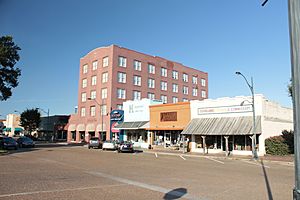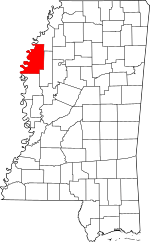Bolivar County, Mississippi facts for kids
Quick facts for kids
Bolivar County
|
|
|---|---|

Grover Hotel in Downtown Cleveland Historic District.
|
|

Location within the U.S. state of Mississippi
|
|
 Mississippi's location within the U.S. |
|
| Country | |
| State | |
| Founded | 1836 |
| Named for | Simón Bolívar |
| Seat | Rosedale and Cleveland |
| Largest city | Cleveland |
| Area | |
| • Total | 906 sq mi (2,350 km2) |
| • Land | 877 sq mi (2,270 km2) |
| • Water | 29 sq mi (80 km2) 3.2% |
| Population
(2020)
|
|
| • Total | 30,985 |
| • Density | 34.200/sq mi (13.205/km2) |
| Time zone | UTC−6 (Central) |
| • Summer (DST) | UTC−5 (CDT) |
| Congressional district | 2nd |
Bolivar County is a county located in the state of Mississippi, right on its western border. As of 2020, about 30,985 people live here. The county has two main towns that serve as its county seats: Rosedale and Cleveland.
The county is named after Simón Bolívar, a famous leader from the early 1800s. He helped several countries in South America gain their freedom from Spain. Bolivar County is part of the Mississippi Delta, an area known for its rich farmland. This region was first used for large cotton farms. Today, other crops like soybeans, corn, and rice are also grown here.
Contents
Bolivar County's Past
Bolivar County was started in 1836. The land originally belonged to the Choctaw people. It was then used for farming because the soil was very good. In 1840, most of the people living in the county were enslaved. This number grew even more by 1860, with about 87% of the population being enslaved. This was because the county's economy relied heavily on farming.
After the Civil War, the county continued to have a large Black population. During the period from 1877 to 1950, the county faced significant racial injustice and violence. In the 1920s, Bolivar County became a key place for the UNIA, an organization that worked for Black empowerment. By the 1960s, the county had an important local civil rights movement. Today, it remains an area with a large Black population.
Where Bolivar County Is Located
Bolivar County covers about 906 square miles. Most of this area, about 877 square miles, is land. The rest, about 29 square miles, is water. It is the second-largest county in Mississippi by land area.
Main Roads
 Future Interstate 69
Future Interstate 69 U.S. Route 61
U.S. Route 61 Mississippi Highway 1
Mississippi Highway 1 Mississippi Highway 8
Mississippi Highway 8 Mississippi Highway 32
Mississippi Highway 32
Neighboring Counties
- Coahoma County (to the north)
- Sunflower County (to the east)
- Washington County (to the south)
- Desha County, Arkansas (to the west)
Protected Natural Areas
People of Bolivar County
| Historical population | |||
|---|---|---|---|
| Census | Pop. | %± | |
| 1840 | 1,356 | — | |
| 1850 | 2,577 | 90.0% | |
| 1860 | 10,471 | 306.3% | |
| 1870 | 9,732 | −7.1% | |
| 1880 | 18,652 | 91.7% | |
| 1890 | 29,980 | 60.7% | |
| 1900 | 35,427 | 18.2% | |
| 1910 | 48,905 | 38.0% | |
| 1920 | 57,669 | 17.9% | |
| 1930 | 71,051 | 23.2% | |
| 1940 | 67,564 | −4.9% | |
| 1950 | 63,004 | −6.7% | |
| 1960 | 54,464 | −13.6% | |
| 1970 | 49,409 | −9.3% | |
| 1980 | 45,965 | −7.0% | |
| 1990 | 41,875 | −8.9% | |
| 2000 | 40,633 | −3.0% | |
| 2010 | 34,145 | −16.0% | |
| 2020 | 30,985 | −9.3% | |
| 2023 (est.) | 28,968 | −15.2% | |
| U.S. Decennial Census 1790-1960 1900-1990 1990-2000 2010-2013 |
|||
2020 Population Information
| Race | Number | Percent |
|---|---|---|
| White | 10,442 | 33.7% |
| Black or African American | 19,923 | 64.3% |
| Native American | 62 | 0.2% |
| Asian | 310 | 1.0% |
| Mixed | 248 | 0.8% |
| Hispanic or Latino | 744 | 2.4% |
In 2020, there were 30,985 people living in Bolivar County. This included 12,114 households and 7,719 families.
Life Expectancy and Poverty
In 2010, data showed that men in Bolivar County could expect to live about 65 years. This was one of the lowest life expectancies in the United States at the time. The national average for men was 76.1 years.
About 40 years earlier, in the 1960s, Senators Robert F. Kennedy and Joseph S. Clark, Jr. visited the Mississippi Delta. They saw areas of great poverty. In Cleveland, they observed African-American children who were barefoot, underfed, and wearing torn clothes. Senator Kennedy said that he thought he had seen the worst poverty in West Virginia, but what he saw in Cleveland was even more difficult. Their visit helped bring attention to the challenges faced by people in the region.
Learning in Bolivar County
Colleges and Universities
- Delta State University (located in Cleveland)
The county is also served by two community colleges: Coahoma Community College and Mississippi Delta Community College.
Public School Districts
Bolivar County has several public school districts:
- Cleveland School District (in Cleveland)
- North Bolivar Consolidated School District (in Mound Bayou)
- West Bolivar Consolidated School District (serving Rosedale, Shaw, and Benoit)
In the past, there were more school districts in the county. In 2012, Mississippi lawmakers suggested combining some of these districts. This was done to save money and help the schools work together better. It's important to know that as recently as the 1960s, the school board in Bolivar County controlled what Black children could learn. They even said that certain subjects, like foreign languages or American history from 1860 to 1875, should not be taught in schools for Black students.
Private School
- Bayou Academy (in Cleveland)
Local News
The Bolivar Commercial was a newspaper that was distributed in Bolivar County.
Towns and Communities
Cities
- Cleveland (a county seat)
- Rosedale (a county seat)
- Mound Bayou
- Shaw (a small part is in Sunflower County)
- Shelby
Towns
Census-Designated Places
These are areas that are like towns but are not officially incorporated.
Unincorporated Places
These are smaller communities without their own local government.
- Choctaw
- Christmas
- Dahomy
- Deeson
- Hushpuckena
- Lamont
- Litton
- Malvina
- O'Reilly
- Perthshire
- Round Lake
- Stringtown
- Waxhaw
Ghost Towns
These are places that used to be towns but are now abandoned.
Famous People From Bolivar County
- Charles Capps
- Charles Clark (governor)
- Charles Clark (judge)
- Medgar Evers
- T.R.M. Howard
- Amzie Moore
- Peter B. Starke, a state representative and senator, and a general in the Civil War
See also
 In Spanish: Condado de Bolivar para niños
In Spanish: Condado de Bolivar para niños

